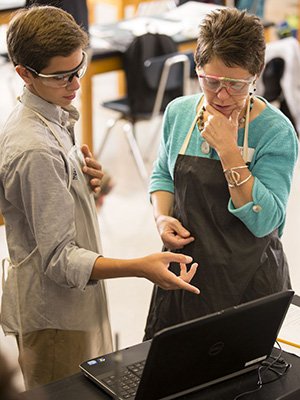Syracuse Hosts First Annual Green Chemistry Think Tank
High school students converge on campus to explore Earth-friendly alternatives to hazardous substances

High school students interested in the emerging field of sustainability chemistry recently converged at Syracuse University for the first annual Green Chemistry Think Tank.
Co-sponsored by the Central New York Section of the American Chemical Society (CNY ACS) and the Manlius Pebble Hill (MPH) School, the event took place in the Life Sciences Complex and involved members of the Department of Chemistry in the College of Arts and Sciences (A&S).
Gary Bonomo G’10 and Miriam M. Gillett-Kunnath G’08—an A&S staffer and researcher, respectively—co-organized the Think Tank with Sue Foster, chair of MPH’s science department.
The event highlighted chemicals, chemical processes and commercial products that do not generate toxins or waste.
“Green chemistry enables us to create Earth-friendly alternatives to hazardous substances,” explains Bonomo, also chair of CNY ACS. “The Think Tank featured demonstrations on recycling, composting and urban gardening. Students also made their own sugar scrubs and enjoyed liquid-nitrogen ice cream.”

The evening program drew more than 60 students from eight area high schools. Foster suspects that because the event was not admissions-driven, participants enjoyed science for the sake of it.
“High school students have minimal opportunity to network with peers from other schools. Feeling the energy of the SU campus and spending the evening talking about science—it’s a win-win for everyone,” she adds.
The program included opening remarks by A&S Dean Karin Ruhlandt, also a Distinguished Professor of Chemistry, and a “sustainability spin wheel,” with which students competed for prizes from A&S, the chemistry department and the Science Teachers Association of New York State (STANYS).
That Gillett-Kunnath's husband, Bobby Kunnath, devised and operated the spin wheel with students from the Institute of Technology at Syracuse Central, where he is a New York State Master Teacher, lent a familiar air to the proceedings. “Sue was amazing, and Gary, as always, was a star with the liquid-nitrogen ice cream,” says Gillett-Kunnath, self-effacingly. A research assistant professor in Ruhlandt’s lab, Gillett-Kunnath also is a technical specialist in Barclay Damon’s Intellectual Property Litigation practice area, a board member of the Milton J. Rubenstein Museum of Science & Technology (MOST) and a recent recipient of the STANYS Excellence in Teaching Award.

She and Bonomo credit Foster for getting the word out to high school and county officials. Witness the involvement, Gillett-Kunnath says, of the Onondaga County Resource Recovery Agency (OCCRA) and “Save the Rain”—the county’s comprehensive storm-water management plan, benefitting Onondaga Lake and its tributaries—at the event.
The Think Tank also featured remarks by local scientists, such as Angela Gaige, the MOST's education director. Other presenters hailed from the Syracuse City School District, SUNY-ESF, MPH’s “Green Avengers” environmental club and the Auburn Enlarged School District.
“Students came from all over Central New York, with those from the Auburn Chemistry Club, accompanied by their organizer, Prin Furst [also a New York State Master Teacher], having come the furthest,” says Bonomo, a lab supervisor and general chemistry lab instructor in A&S. “A lot of people banded together to make the day an enrichening experience.”
Even SU students got in on the action. Chemistry majors Ashley Clements and Meghan Vonden Steinen helped Bonomo serve up fresh, made-to-order, liquid-nitrogen ice cream. “It was dessert, with a side of science,” he jokes. “I couldn’t have done it without them.”
Foster recalls one attendee who turned up alone and unannounced, admitting she had forgotten to register for the Think Tank and that no one from her school offered to accompany her. “She asked me if it was okay to stay, and I said, ‘Of course,’” Foster recalls. “The evening turned out to be pivotal for her.”
